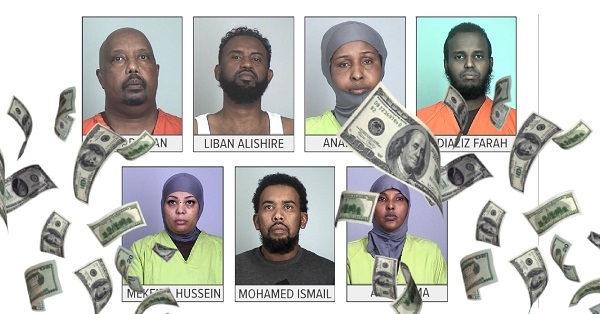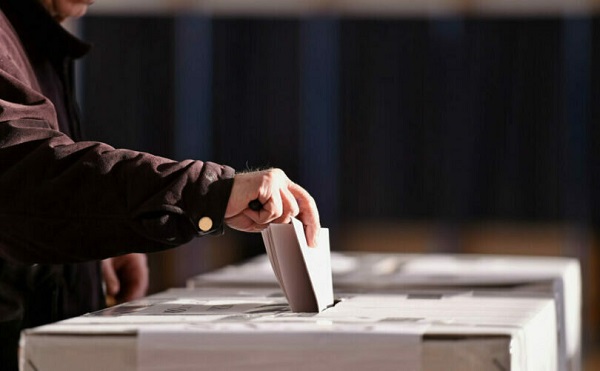Business
The SBF Scandal: The Players and the Money

From the Brownstone Institute
BY
The complexities of the FTX scandal with Sam Bankman-Fried at the helm boggles the mind. Unlike the Madoff scandal, which was incredibly simple, the funding, influence, and political networks sounding the $32 billion collapse of FTX is byzantine by design.
Just have a look at the org chart of the company to get a sense. It’s all the better for avoiding oversight.

What we really need in the months or even years in which it will take to sort all of this out is some kind of key to the major players. What follows is a list which we’ve put together in order of network importance for easy reference. This small effort is made necessary because there seems to be very little attention being given to the entire SBF empire, both in terms of the players with whom he worked and where the money ended up.
It’s nowhere near being a guide to the fullness of the networks of funding and influence, and can only begin to hint at the real story of what was really behind this magic bean factory in the Bahamas. Their operations and networks are deliberately obscure and fan out over many countries, institutions, and individuals. There is a strange silence in the air about the details other than the general observation that Sam Bankman-Fried was up to no good.
And yet there were obviously many people involved. It’s probable that the main point was to fund political causes in a way that gets around federal election law, as the indictment suggests in count eight. However, a close examination of the networks keeps coming back to the strange theme of pandemic planning and support for various methods of controlling the population in the name of controlling infectious disease. Aside from political donations, this was a central concern. What that has to do with a crypto exchange is another matter.
All of which should raise a question given the time of the life of FTX (2019-2022): to what extent was the network surrounding this institution useful in providing back-channel funding support for (and lack of opposition to) the most unprecedented attack on human liberty in our lifetimes? This question applies to both the direct political contributions and the various other donations to institutions and individuals.
Corrections to this list are welcome.
Family
Sam Bankman-Fried: Went to MIT, worked for Centre for Effective Altruism (fundraising 2017) and started Alameda Research in November 2017, and then the crypto trading company FTX two years later, which he ran until 2022 when it all collapsed after becoming the second-largest donor to Democrats ($38M).
Barbara Helen Fried: mother of Sam, Harvard Law graduate, professor at Stanford University, booster of Effective Altruism, and founder of Mind the Gap, a secretive political action committee in Silicon Valley.
Alan Joseph Bankman: father of Sam, Yale Law graduate and later clinical psychologist, law professor at Stanford, and author and expert on tax law.
Linda Fried: Sam’s aunt on his mother’s side and Dean of School of Public Health at Columbia University and on the board of the World Economic Forum’s Global Agenda Council on Aging.
Gabriel Bankman-Fried: Sam’s brother who ran Guarding Against Pandemics, a lobbying organization supporting “pandemic planning” also known as lockdowns and vaccine mandates. It has a Capitol Hill headquarters that cost $3.3 million. He previously served on a Congressional staff.
Associates
Caroline Ellison: Schooled at Stanford, she is daughter of Glenn Ellison and Sara Fisher Ellison, both professors at MIT. She became CEO of Sam’s Alameda Research and reported girlfriend of Sam’s.
Sara Fisher Ellison and Glenn Ellison: Caroline’s mother is professor of economics at MIT with a research specialization in the pharmaceutical industry while her father has written at least four papers on epidemiological modeling.
Nishad Singh: former MIT roommate of Sam’s who is said to have built the FTX platform. He seems to have left the Bahamas for India.
Zixiao “Gary” Wang: Co-founder with Sam of FTX and Alameda. He graduated from MIT and worked for Google. Beyond that hardly anything is known about him. He seems to have left the Bahamas and is reported to be in Hong Kong.
Ryan Salame: Graduate of UMass-Amherst and head of FTX Digital Markets, plus proprietor of R Salame Digital Asset Fund through the Berkshire Taconic Community Foundation, allegedly for charitable purposes.
William David MacAskill: real name Crouch, William is an author and philosopher and founder of the Centre for Effective Altruism and a close colleague of Sam’s. He served on the board of FTX Future Fund until it collapsed. He is a media personality who gives TED talks and is a leader purveyor of the view that one should get very rich and give it away.
Funded Institutions and Individuals (some taken from here)
Together Trial: This elaborate trial of therapeutics ended up inveighing against Ivermectin and Hydroxychloroquine and was generously funded by FTX. But that has been scrubbed from the public website. This is a continuing problem.
Moncef Slaoui: The head of Operation Warp Speed, he received $150,000 from FTX to write SBF’s autobiography, according to a Washington Post investigation.
HelixNano: A vaccine company that claims to be developing mutation-resistant vaccines, which received $10M in funding from FTX Future Fund, according to a Washington Post investigation.
Johns Hopkins Center for Health Security: This institution ran the Event 201 lockdown tabletop exercise in 2019, and received at least $175,000 for a single employee, from FTX coffers. We don’t know the full extent but it was enough for the head of the Center to defend Sam and FTX in public. Nor do we know Alameda Research’s funding reach of this institution.
Guarding Against Pandemics: Run by Sam’s brother Gabriel, this 501c4 gave at least $1M to campaigns in 2022. We do not know how much money Alameda/FTX funneled to this institution. Sam fequently recommend it as a target for charitable giving.
Protect Our Future: run by the two brothers, this PAC gave $28M to candidates in the 2022 cycle. We do not know how much Alameda/FTX gave.
Center for Innovation in Global Health, Stanford University: FTX and its network gave $1.5M to the institution.
ProPublica: A grant of $5M from FTX Future Fund. Other reports say $27 million.
Centre for Effective Altruism: FTX Future fund gift of $14M
Effective Ideas Blog: It promised to pay $1K to good blogs, and its Twitter frequently links to other institutions and individuals in the FTX network. Funded by Future Fund: $900K
Piezo Therapeutics: “Work on technology for delivering mRNA vaccines without lipid nanoparticles with the aim of making vaccines more safe, affordable, and scalable.” FTX gave $1M
Council on Strategic Risks: “a project which will develop and advance ideas for strengthening regional and multilateral cooperation for addressing biological risks.” $400K from FTX
AVECRIS Pte. Ltd: “support the development of a next-generation genetic vaccine platform that aims to allow for highly distributed vaccine production using AVECRIS’s advanced DNA vector delivery technology.” $3.6M from FTX
University of Ottawa: “a project to develop new plastic surfaces incorporating molecules that can be activated with low-energy visible light to eradicate bacteria and kill viruses continuously.” FTX gave $250K
1Day Sooner: “work on pandemic preparedness, including advocacy for advance market purchase commitments, collaboration with the UK Pandemic Ethics Accelerator.” FTX gave $300K.
SAGE: “creation of a pilot version of a forecasting platform, and a paid forecasting team, to make predictions about questions relevant to high-impact research.” FTX gave $700K
Longview: “global priorities research, nuclear weapons policy, and other longtermist issues.” Advisor: William MacAskill. FTX gave $15M
Confirm Solutions: “support development of statistical models and software tools that can automate parts of the regulatory process for complex clinical trials.” FTX gave $1M
Lightcone Infrastructure: “ongoing projects including running the LessWrong forum, hosting conferences and events, and maintaining an office space for Effective Altruist organizations.” FTX gave $2M
Rational Animations: “the creation of animated videos on topics related to rationality and effective altruism to explain these topics for a broader audience.” FTX gift: $400K
Giving What We Can: “to create a world in which giving effectively and significantly is a cultural norm.” FTX gift: $700,000
The Atlas Fellowship: scholarships for talented and promising high school students to use towards educational opportunities and enrolling in a summer program. FTX gift: $5M
Constellation: “support 18 months of operations for a longtermist coworking space in Berkeley.” FIX coughed up $3.9M
Longview Philanthropy: “creating a longtermist coworking office in London.” FTX committed $2.9M
Long Term Future Fund: “longtermist grantmaking.” FTX committed $3.9M
OurWorldinData: graphs and charts portal. FTX committed $7.5M
Institute for Progress: “research and policy engagement work on high-skilled immigration, biosecurity, and pandemic prevention.” FTX was in for $480K. Additional support came from Emergent Ventures, which was modeled on Fast Grants that funded Neil Ferguson’s pandemic modeling at Imperial College London, which seems to have an entangled relationship with the SFB empire, one yet to be fully disclosed.
Conclusion
What is listed above only scratches the surface of the admitted $160 million given out, but the promise had been for fully $1 billion to go to various nonprofits in this network that seems to be supported or even founded in order to receive money from FTX-connected institutions.
We could only list some of the names and a fraction of the dollar amounts. There are many other institutions and names that could be part of this list but we lacked enough documentation to verify for this article. There is still the task of listing all political campaigns that were in receipt of the money as well as the public-relations boosters of the whole effort.
Building off the success of Bill Gates, Sam Bankman-Fried, and his many associates, clearly saw philanthropy as the path to influence, power, and protection. At the same time, many nonprofit organizations saw an opportunity too; to build their own empires through promised millions and billions from a crypto genius in the Bahamas who had an unusual passion for pandemic planning.
For three years, many of us have wondered how it came to be that the critics of lockdowns and mandates were so few and far between. There are surely many explanations but, as usual, it helps fill in the dots to follow the money.
Business
Feds pull the plug on small business grants to Minnesota after massive fraud reports

The Small Business Administration is moving to freeze grant money flowing into Minnesota after explosive allegations of large-scale fraud tied to state oversight failures, with SBA Administrator Kelly Loeffler signaling an immediate crackdown following recent independent reporting.
In a series of comments shared publicly by conservative commentator Benny Johnson, Loeffler said the agency is “cutting off and clawing back” SBA grants to the state while investigators dig deeper into what she described as a rapidly expanding fraud network.
Johnson wrote that Loeffler told him she was “disgusted and sickened” after reviewing footage from YouTuber Nick Shirley, whose on-the-ground reporting in Minnesota highlighted what he said were sham daycare and learning centers collecting millions in public funds despite showing little or no sign of legitimate operations.
According to Johnson, Loeffler blamed the situation on Democrat Gov. Tim Walz, accusing his administration of refusing to enforce basic rules governing small businesses and allowing fraud to flourish unchecked.
Johnson said Loeffler told him SBA investigators were able to identify roughly half a billion dollars in suspected fraud within days of focusing on Minnesota, calling the operation an “industrial-scale crime ring” that ripped off American taxpayers.
“Pending further review, SBA is freezing all grant funding to the state in order to stop the rampant waste of taxpayer dollars and uncover the full depth of fraud,” Loeffler said, according to Johnson’s account, adding that the total scope of the scheme remains unknown and could reach into the billions.
The controversy gained national traction after Shirley posted video of himself visiting multiple facilities, including a South Minneapolis site known as the Quality Learning Center, which he reported was approved for federal aid for up to 99 children but appeared inactive during normal business hours.
The center’s sign, Shirley noted, even misspelled the word “learning” as “learing.”
In the footage, a woman inside the building is heard shouting “Don’t open up,” falsely claiming Shirley and his colleague were Immigration and Customs Enforcement agents.
After the video circulated, Rep. Tom Emmer, a Republican, publicly demanded answers from Walz, questioning how such facilities were approved for millions in taxpayer funding.
Shirley’s reporting followed earlier investigations, including a November report by City Journal alleging that members of Minnesota’s Somali community had sent millions of dollars in stolen taxpayer funds overseas, with some of that money reportedly ending up in the hands of Al-Shabaab, a U.S.-designated terrorist organization.
While Walz’s administration has insisted it takes fraud seriously, the SBA’s decision to halt grant funding marks one of the most aggressive federal responses yet, underscoring how rapidly a local scandal has escalated into a national reckoning over oversight, enforcement, and accountability in Minnesota.
Business
Stripped and shipped: Patel pushes denaturalization, deportation in Minnesota fraud

FBI Director Kash Patel issued a blunt warning over the weekend as federal investigators continue unraveling a sprawling fraud operation centered in Minnesota, saying the hundreds of millions already uncovered represent “just the tip of a very large iceberg.”
In a lengthy statement posted to social media, Patel said the Federal Bureau of Investigation had quietly surged agents and investigative resources into the state well before the scandal gained traction online. That effort, he said, led to the takedown of an estimated $250 million fraud scheme that stole federal food aid intended for vulnerable children during the COVID pandemic.
According to Patel, the investigation exposed a network of sham vendors, shell companies, and large-scale money laundering operations tied to the Feeding Our Future case. Defendants named by the FBI include Abdiwahab Ahmed Mohamud, Ahmed Ali, Hussein Farah, Abdullahe Nur Jesow, Asha Farhan Hassan, Ousman Camara, and Abdirashid Bixi Dool, each charged with offenses ranging from wire fraud to conspiracy and money laundering.
Patel also said Abdimajid Mohamed Nur and others were charged in a separate attempt to bribe a juror with $120,000 in cash. He noted that several related cases have already resulted in guilty pleas, prison sentences of up to 10 years, and nearly $48 million in restitution orders.
Despite those outcomes, Patel warned the case is far from finished.
“The FBI believes this is just the tip of a very large iceberg,” he said, adding that investigators will continue following the money and that the probe remains ongoing. Patel further confirmed that many of those convicted are being referred to immigration authorities for possible denaturalization and deportation proceedings where legally applicable.
The renewed focus follows a viral video circulated by independent journalist Nick Shirley, which appeared to show multiple childcare and learning centers operating as empty or nonfunctional storefronts. The footage sparked immediate backlash from Republicans, including Vice President JD Vance.
House Majority Whip Tom Emmer accused Minnesota Gov. Tim Walz of sitting idle while massive sums were stolen from taxpayers. Walz addressed the allegations during a November press conference, before the full scope of the fraud became public, saying the scandal “undermines trust in government” and threatens programs meant to help vulnerable residents.
“If you’re committing fraud, no matter where you come from or what you believe, you are going to go to jail,” Walz said at the time.
Authorities say the alleged schemes date back to at least 2015, beginning with overbilling Minnesota’s Child Care Assistance Program and later expanding into Medicaid-funded disability and housing programs. One such housing initiative, aimed at helping seniors and disabled residents secure stable housing, was shut down earlier this year after officials cited what they described as large-scale fraud.
The fallout has already reached the federal level. Last month, President Trump announced the suspension of Temporary Protected Status for Somali nationals, arguing that Minnesota had become a hub for organized welfare fraud and money laundering activity.
-

 Digital ID1 day ago
Digital ID1 day agoCanadian government launches trial version of digital ID for certain licenses, permits
-

 Alberta1 day ago
Alberta1 day agoAlberta Next Panel calls to reform how Canada works
-

 International1 day ago
International1 day agoGeorgia county admits illegally certifying 315k ballots in 2020 presidential election
-

 Agriculture2 days ago
Agriculture2 days agoEnd Supply Management—For the Sake of Canadian Consumers
-

 Business1 day ago
Business1 day agoThe “Disruptor-in-Chief” places Canada in the crosshairs
-

 Artificial Intelligence1 day ago
Artificial Intelligence1 day agoUK Police Pilot AI System to Track “Suspicious” Driver Journeys
-

 Energy1 day ago
Energy1 day ago‘The electric story is over’
-

 International1 day ago
International1 day agoWorld-leading biochemist debunks evolutionary theory







